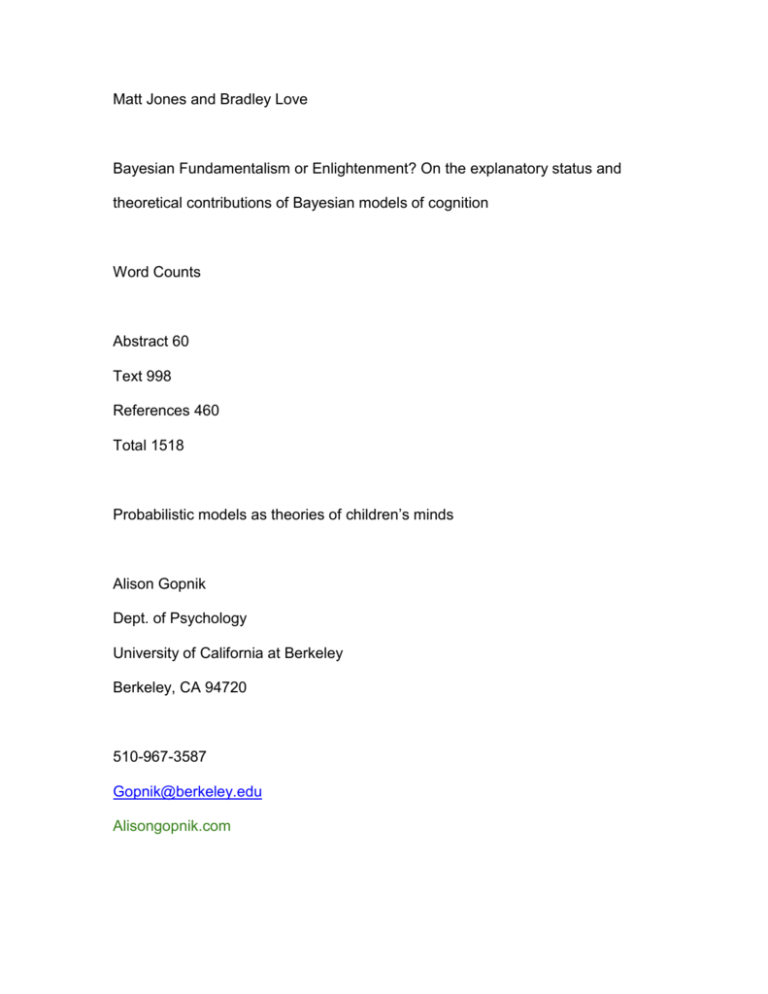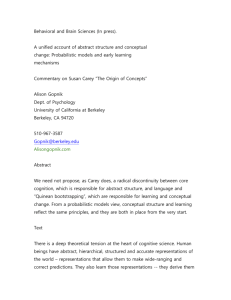Probabilistic models as theories of children`s minds
advertisement

Matt Jones and Bradley Love Bayesian Fundamentalism or Enlightenment? On the explanatory status and theoretical contributions of Bayesian models of cognition Word Counts Abstract 60 Text 998 References 460 Total 1518 Probabilistic models as theories of children’s minds Alison Gopnik Dept. of Psychology University of California at Berkeley Berkeley, CA 94720 510-967-3587 Gopnik@berkeley.edu Alisongopnik.com Abstract Our research program proposes that children have representations and learning mechanisms that can be characterized as causal models of the world – coherent, structured, hypotheses with consistent relationships to probabilistic patterns of evidence. We also propose that Bayesian inference is one mechanism by which children learn these models from data. These proposals are straightforward psychological hypotheses and far from “Bayesian fundamentalism” . Text So who exactly are these Bayesian fundamentalists? Since I don’t know or know of any researchers who fit Jones and Love’s description, I can’t defend them. Instead, let me describe what my colleagues and I have actually done over the last ten years. Our research program has proposed that children have representations and learning mechanisms that can be characterized as causal models of the world – coherent, structured, hypotheses with consistent and predictable relationships to probabilistic patterns of evidence, and that Bayesian inference is one mechanism by which children may learn these models from data. This proposal has exactly the same status as any other claim in psychology. Since the cognitive revolution, it has been a commonplace that we can explain the mind in terms of representations and rules. It is also a commonplace of the philosophy of cognitive science that these representations and rules can involve many levels of abstraction, from high-level representations like “intuitive theories” to neural representations of three-d structure. In vision science, for example, the poster child of successful cognitive science, explanations at many levels from ideal observer theories to neural implementations have been mutually illuminating. Bayesian learning is just one part of a broader approach, better called the “probabilistic model” approach, (See Gopnik & Schulz, 2007 and Griffiths et al, 2010; for applications to cognitive development see Gopnik et al. 2004; and special sections of Developmental Science (2007) and Cognition (in press).) The central advance has not been Bayes’ law itself, but the ability to formulate structured representations, such as causal graphical models, or “Bayes nets”, (Spirtes, Glymour & Scheines, 1993; Pearl, 2000) or hierarchical causal models, category hierarchies or grammars, that can be easily combined with probabilistic learning, such as Bayesian inference. I agree with Jones and Love that formal models are only useful if they can help address empirical questions. For developmental psychologists the great question is how children can learn as much as they do about the world around them. In the past “theory theorists” proposed that children learn by constructing hypotheses and testing them against evidence. But if this is a deterministic process then the “poverty of the stimulus” problem becomes acute. In contrast, if the child is a probabilistic learner, weighing the evidence to strengthen support for one hypothesis over another, we can explain how children are gradually able to revise their initial theories in favor of better ones. Empirically, we’ve discovered, as a result of extensive and often challenging experiments, that young children do indeed behave like probabilistic learners – rather than simply using associationist mechanisms to match the patterns in the data or fiddling with details of innate core knowledge. The framework lets us make precise predictions about how children will behave, for example, that they will infer a common cause structure with one set of evidence, but infer a causal chain in an almost identical task with slightly different evidence (Schulz et al. 2007a). From a more specifically Bayesian perspective it also allows us to make predictions about the probability of particular responses. The empirical likelihood that a child will make one prediction or another is closely matched to the posterior distribution of hypotheses that support those predictions (eg Schulz et al. 2007b). The ultimate test of any perspective is whether it generates new and interesting empirical research. Researchers inspired by this approach have already begun to make important developmental discoveries, discoveries that don’t fit either a connectionist/dynamic or nativist picture. 9-month-olds, for example, can make causal inferences that go beyond association (Sobel and Kirkham, 2006) 20month-olds can infer a person’s desire from a non-random sampling pattern (Kushnir, Xu and Wellman, 2010) , and 4-year-olds discover new abstract variables and rules from only a few data points (Schulz et al. 2008; Lucas et al, 2010), integrate new evidence and prior knowledge (Schulz et al. 2007b; Kushnir & Gopnik 2007, Sobel et al, 2004) and rationally experiment to uncover new causal structure (Schulz & Bonawitz, 2007). The framework has also allowed us to identify cases where children behave in ways that are interestingly different from ideal inference engines. For example, Kushnir & Gopnik (2005) showed that children weight their own actions more heavily than they normatively should for purposes of causal inference. Bonawitz et al. (2010) have shown that two-year-olds have difficulty integrating purely correlational information and information about the outcomes of actions. The precision of these models also allows us to test competing hypotheses. For example, we recently described formal models of learning by imitation which gave different weights to statistical evidence and a demonstrator’s intentions (Buchsbaum et al. in press). Comparing the models with the data allowed us to show that young children make prior assumptions about why people act, and that these assumptions can explain why they sometimes “overimitate”, reproducing everything that the teacher does, and also predict the degree to which overimitation will occur. It would certainly be helpful to relate these more abstract accounts to algorithmic level instantiations, this has already been done to some extent (Danks, 2003) and we are working on precisely this problem in my lab and others at the moment (Bonawitz et al., 2010). Ultimately, we would also like to relate these representations to neural implementations. It might also be interesting to relate these findings to memory or attention. But this is simply the usual scientific work of connecting different research programs, and we can’t tell which connections will be illuminating beforehand. There is nothing privileged about information processing or neuroscience that means that such research is about “mechanisms” while research into representations is not. This would be like rejecting the explanation that my computer saved the file when I pushed ctrl-s because ctrl-s is the save command in Windows, since this explanation doesn’t refer to the computer’s working memory or wiring diagrams. I would be happy if Jones and Love saw this research program as a part of the Bayesian enlightenment. If so, however, it is an enlightenment that has been in place for at least ten years. References Bonawitz, E. B., Ferranti, D., Saxe, R., Gopnik, A., Meltzoff, A. N., Woodward, J., et al. (2010). Just do it? Investigating the gap between prediction and action in toddlersʼ causal inferences. Cognition, 115(1), 104-17. Buschbaum, D., Griffiths, T. L., & Gopnik, A. (In Press). Children's Imitation of Causal Action Sequences is Influenced by Statistical and Pedagogical Evidence. Cognition. Danks, D. (2003). Equilibria of the Rescorla–Wagner model. Journal of Mathematical Psychology, 47(2), 109-121. Gopnik, A,; Glymour, C.; Sobel, D.; Schulz, L.; Kushnir, T.; Danks, D. (2004). A theory of causal learning in children: Causal maps and Bayes nets. Psychological Review, 111(1),3-32 Gopnik, A. & Schulz L. (eds). (2007). Causal learning: Philosophy, psychology and computation. NY, NY: Oxford University Press. Griffiths. T., Chater, N., Kemp, C., Perfors, A. & Tenenbaum, J. (2010) Probabilistic models of cognition: Exploring representations and inductive biases. Trends in Cognitive Sciences Vol 14(8), Aug 2010, pp. 357-364 Kemp, C.; Tenenbaum, J. B, Niyogi, S. & Griffiths, T. (2010). A probabilistic model of theory formation. Cognition, 114, 2 , 165-196. Kushnir, T., & Gopnik, A. (2005). Young Children Infer Causal Strength From Probabilities and Interventions. Psychological Science, 16(9), 678-683. Kushnir, T. & Gopnik, A. (2007). Conditional probability versus spatial contiguity in causal learning: Preschoolers use new contingency evidence to overcome prior spatial assumptions. Developmental Psychology, 43(1), 186-196. Kushnir, T., Xu, F. & Wellman, H. (2010) Young children use statistical sampling to infer the preferences of others. Psychological Science. 21, 1134-1140. Lucas C., Gopnik, A. & Griffiths, T. (2010) Developmental differences in learning the form of causal relationships. In S. Ohlsson & R.Catrambone (Eds.), Proceedings of the 32nd Annual Conference of the Cognitive Science Society (pp. 2852-2857). Austin, TX: Cognitive Science Society.. Pearl, J. (2000). Causality. Cambridge, UK: Cambridge University Press. Schulz, L.; Goodman, N.; Tenenbaum, J.; & Jenkins, A. (2008). Going beyond the evidence: Abstract laws and preschoolers' responses to anomalous data. Cognition 109(2), 211-223. Schulz, L. E. & Bonawitz, E. B. (2007). Serious fun: Preschoolers engage in more exploratory play when evidence is confounded. Developmental Psychology, 43, 1045-1050. Schulz, L. E., Bonawitz, E. B., & Griffiths, T. L. (2007). Can being scared cause tummy aches? Naive theories, ambiguous evidence, and preschoolersʼ causal inferences. Developmental psychology, 43(5), 1124-39. Schulz, L. E, Gopnik, A., & Glymour, C. (2007). Preschool Children Learn About Causal Structure From Conditional Interventions. Developmental Science, 10(3), 322-32. Sobel, D. M., & Kirkham, N. Z. (2006). Blickets and babies: The development of causal reasoning in toddlers and infants. Developmental Psychology, 42(6), 1103. Sobel, D. M., Tenenbaum, J. B., & Gopnik, A. (2004). Childrenʼs causal inferences from indirect evidence: Backwards blocking and Bayesian reasoning in preschoolers. Cognitive Science, 28(3), 303-333. Spirtes, P., Glymour, C., & Scheines, R. (2000). Causation, prediction, and search 2nd Edition. Cambridge: MIT Press








